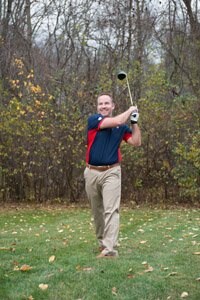Arthroscopic Shoulder Surgery
Back to 100 Percent
 Roger Paquette of Blackstone remembers how his shoulder pain started gradually, then built to the point where he couldn’t sleep on his right side. It also bothered him when he went running or played golf. After six months, the pain intensified – no longer a nagging twinge, but a throbbing ache. Frustrated, he made an appointment with Dr. Michael A. Vazquez, an orthopedic specialist at Mulroy Orthopaedic Surgery and Sports Medicine on Fortune Boulevard in Milford, which specializes in joint replacement and sports medicine surgery.
Roger Paquette of Blackstone remembers how his shoulder pain started gradually, then built to the point where he couldn’t sleep on his right side. It also bothered him when he went running or played golf. After six months, the pain intensified – no longer a nagging twinge, but a throbbing ache. Frustrated, he made an appointment with Dr. Michael A. Vazquez, an orthopedic specialist at Mulroy Orthopaedic Surgery and Sports Medicine on Fortune Boulevard in Milford, which specializes in joint replacement and sports medicine surgery.
“I couldn’t really deal with it anymore, so I saw him in the fall of 2014,” recalls Roger, who ultimately had arthroscopic shoulder surgery at Milford Regional in June 2015. “I’m only forty and a little young to be in constant pain. I just wanted to be able to be day-to-day pain-free, to roll over without being in pain, and to work out and play golf.”
He appreciated that Dr. Vazquez tried a conservative approach at first and didn’t push surgery. Instead, the doctor recommended a cortisone injection. It seemed promising, but then the relief faded, Roger notes. “The response was almost immediate and it felt great for about six weeks,” he says. “We did another injection and had the same result, but it only lasted three and a half weeks this time. Then we started talking about the other alternative, which was surgery.”
Dr. Vazquez performs a lot of arthroscopic surgery on the shoulder and knee, and says that the most common procedures are primarily rotator cuff repair, ACL reconstruction, meniscus tears, and dislocated shoulder repairs. According to Dr. Vazquez, there are many causes of shoulder pain, including instability, dislocation, fractures, sprains, tendonitis and bursitis. Arthritis and degenerative conditions of the large ball and socket joint along with the "AC" (small) joint can also cause chronic shoulder pain. Common problems are rotator cuff injuries, frozen shoulder and impingement syndrome.
“Not everyone needs surgery right away and most people don’t ever need surgery,” acknowledges Dr. Vazquez. “For Roger, we tried rest, icing it, anti-inflammatory medication and the cortisone injections. After the second cortisone shot gave relief for only a few weeks, Roger had an MRI. It revealed that his AC joint was worn down and inflamed.”
Roger spent a few months considering surgery and determining a convenient time to have it done. Finally last spring, he booked the procedure for June. Dr. Vazquez told Roger that shoulder arthroscopy uses a tiny camera called an arthroscope to examine and facilitate repair of the tissues inside or around the shoulder joint. The arthroscope, inserted through a small cut in the skin, connects to a video monitor in the operating room.
During Roger’s procedure, Dr. Vazquez saw some partial tearing of the rotator cuff. “I was able to remove the fraying,” he says. “That’s one of the benefits of arthroscopic surgery. You can take care of the problem you know of, and then you can look around at the whole shoulder and take care of what the MRI might have missed. Incisions depend on the complexity. Roger had three small incisions about a centimeter long. They have to be large enough to fit instruments the size of a pen. Large tears could have five or six small incisions all around the shoulder. You can get to the front, the side and back of the shoulder by just a small incision. I use as few incisions as I can to do the surgery correctly."
At the end of the surgery, the incisions were closed with stitches and covered with a dressing. Roger said he went to Milford Regional at 7 a.m. and was home, with his arm in a sling, by 12:30 p.m. He opted for a nerve block beforehand, which numbed his arm and eased his recovery. “I would never have known I had surgery when I woke up,” recalls Roger.
Once it wore off, he had pain pills for a couple days, but tolerated post-surgical discomfort better than the constant throbbing he had experienced for months before surgery. Roger worked from home and then returned to his sales job the following week. He started running about a month after the surgery and now feels 100 percent. Roger said he was so pleased with the practice that he brought his teenage daughter there for a soccer injury and referred his father for knee surgery.
In addition to sports medicine and shoulder surgery, Mulroy Orthopaedic Surgery and Sports Medicine’s specialty services include total joint replacements, fracture management, hand and wrist surgery, knee surgery, elbow surgery, foot and ankle surgery. Along with Dr. Vazquez, the practice includes orthopedic specialists John Mulroy, MD, and Susan Barrett, MD.
“They’re fantastic," says Roger. "I’m a coach for the town’s travel soccer league, and whenever anyone has an injury, I suggest that they go there. Dr. Vazquez never once pushed surgery on me and told me that it would be a last resort. He took his time and is a great guy. I trusted him throughout the whole process.”
Read more about Michael Vazquez, MD